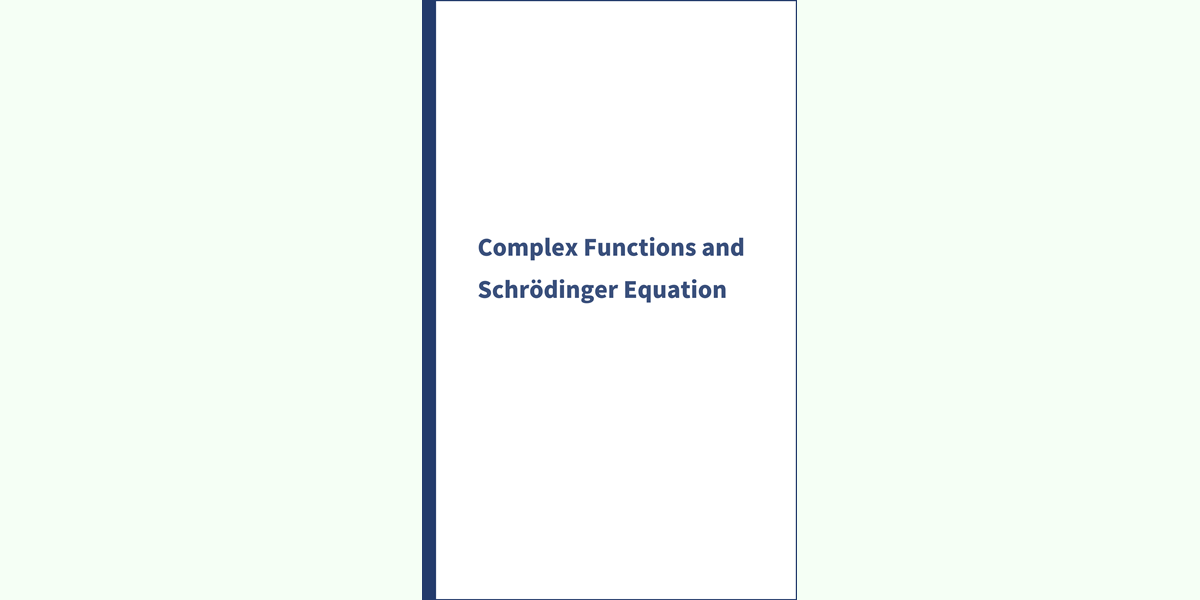“Complex Functions and Schrödinger Equation” is the title of an e-book I wrote, so I would like to write a short story about this title. If you just look at the title, it would seem like something written by a leading figure in that academic field. It’s a title that is likely to get people angry, as if it’s some kind of arrogant title from a complete amateur who isn’t even a scholar. However, to tell the truth, I suspect that there is no other book with this title other than my own (I apologize if I’m wrong).I searched as much as I could for existing book titles, but I couldn’t find any book with this title, so I decided to use it as the title of my own book. In short, while at first glance it appears to be a standard textbook written by a leading figure in the field, it is actually the title of a quirky book, and is therefore a satirical title that suits the author’s taste.
With this title, the content would be structured to first explain the theory of calculus for complex functions (theory of holomorphic functions) and then, as an application, show the theory of the Schrödinger equation as a partial differential equation for complex functions. However, are there any mathematicians or physicists who can connect this theory of holomorphic functions with the Schrödinger equation and present a mathematical theory? The derivative of a complex function in the Schrödinger equation is calculated in the same form as the derivative of a real multivariate function, and is calculated completely ignoring conditions such as holomorphic functions. In short, the Schrödinger equation not only does not require the theory of calculus regarding complex functions, but it also appears to have no problems arbitrarily defining and calculating the derivatives of complex functions, which complex function theory says cannot be differentiated. The reason why it is highly likely that a book with this title does not exist is because it would be difficult to explain a mathematical theory in a way that reconciles these two theories.
So, how did I structure my argument? You can find out by looking at the contents of the book, but I will just explain the gist of it. When it comes to complex function theory, most people end up understanding the theory of complex functions of one variable (or giving up because they can’t understand it). However, when trying to deal with the Schrödinger equation within the framework of complex function theory, it cannot be dealt with as a complex function of one variable, and needs to be expanded to a complex function of two variables. Instead of \(\small f(z)\), we must treat it as \(\small f(z, \bar{z}) \). This extension results in properties that differ from complex functions of one variable, and the derivatives of complex functions can be calculated in the same way as derivatives of real functions of multiple variables. This type of derivative of a complex function is called the Wirtinger derivative, named after its proposer. When we consider the Schrödinger equation using this concept of differentiation, we come across many ideas that differ from common sense…but I will leave the rest to the book.
By the way, when it comes to the theory of complex functions of multiple variables, the treatment of holomorphic functions is often not defined using limit operations or the Cauchy-Riemann relation, and
\[ \small \frac{\partial f(z, \bar{z})}{\partial \bar{z}} \equiv 0\]
is considered as the conditions using the Wirtinger derivative. It is the condition that a holomorphic function must satisfy, and is apparently called the \(\small \bar{\partial}\)-equation (pronounced as d-bar equation). The wave function dealt with in the Schrödinger equation is a complex function that is not zero, and so we define and calculate the partial derivatives of complex functions that are not holomorphic functions. If you think about it normally, you might ask, “Is it really okay to define a derivative like that?”, but I have a personal prejudice that mathematicians are not good at breaking down common sense in this way. In this sense, many readers may find the author’s arguments confusing. However, I think it would be good if people could enjoy it, including those confusing parts.
Also, after rereading it, I still don’t feel I fully understand the calculations involving eigenvalues. What this means is that it is not well understood why the physical quantities observed are only the eigenvalues of a matrix (operator). It is likely that there are elements related to time and the fact that space is in spherical coordinates that can only take on discrete values, but I get the impression that this is still nothing more than a hypothesis. I plan to post an article about this on my blog once I understand it better.
Reference
[1] Hirano, Kaname (2024), Complex Functions and Schrödinger Equation, Amazon Kindle Store.



Comments